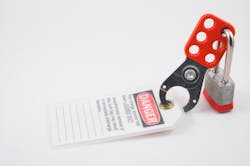At one time, lockout/tagout training was typically some minimal classroom instruction thing done to “check off the box,” and management in most companies was happy with this. The problem is that such inadequacy got a lot of people hurt or killed while destroying millions of dollars of equipment annually.
In certain environments, such as power-generating stations, and certain fields, such as electrical testing, lockout/tagout training was much more rigorous. It involved instruction, demonstration, and practical application while being monitored by a qualified person. And employees would be trained not just once, but retrained (typically on a schedule).
It should not be amazing to anyone that in these environments, the injury, death, and damage outcomes were far different from those that were laxer.
This better way of training made its way into the 2018 version of NFPA 70E [110.2(B)]. It’s broken down into three phases:
- Initial training. Not only must the employee be trained in the procedures, but the employee must also be trained to understand what their responsibility is in the execution of the procedures.
- Retraining. Three criteria are given for when retraining should take place. While some firms have shorter timeframes for this, NFPA 70E requires it at three-year intervals (at a maximum). If the procedure changes, training in the revised procedure must occur. Of course, any time an employee shows a need to be retrained (e.g., through incorrect execution), retraining must occur.
- Documentation of training. Keep records of who, what, and when — adding “where” doesn’t hurt either.
About the Author

Mark Lamendola
Mark is an expert in maintenance management, having racked up an impressive track record during his time working in the field. He also has extensive knowledge of, and practical expertise with, the National Electrical Code (NEC). Through his consulting business, he provides articles and training materials on electrical topics, specializing in making difficult subjects easy to understand and focusing on the practical aspects of electrical work.
Prior to starting his own business, Mark served as the Technical Editor on EC&M for six years, worked three years in nuclear maintenance, six years as a contract project engineer/project manager, three years as a systems engineer, and three years in plant maintenance management.
Mark earned an AAS degree from Rock Valley College, a BSEET from Columbia Pacific University, and an MBA from Lake Erie College. He’s also completed several related certifications over the years and even was formerly licensed as a Master Electrician. He is a Senior Member of the IEEE and past Chairman of the Kansas City Chapters of both the IEEE and the IEEE Computer Society. Mark also served as the program director for, a board member of, and webmaster of, the Midwest Chapter of the 7x24 Exchange. He has also held memberships with the following organizations: NETA, NFPA, International Association of Webmasters, and Institute of Certified Professional Managers.
